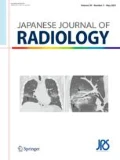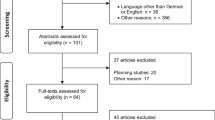Abstract
Purpose
Multimodality therapy for esophageal cancer can cause various kinds of treatment-related sequelae, especially pulmonary toxicities. This prospective study aims to investigate the clinical and dosimetric parameters predicting lung injury in patients undergoing radiation therapy for esophageal cancer.
Methods
Forty-five esophageal cancer patients were prospectively analyzed. The pulmonary toxicities (or sequelae) were evaluated by comparing chest X-ray films, pulmonary function tests and symptoms caused by pulmonary damage before and after treatment. All patients were treated with either three-dimensional radiotherapy (3DCRT) or with intensity-modulated radiotherapy (IMRT). The planning dose volume histogram was used to compute the lung volumes receiving more than 5, 10, 20 and 30 Gy (V5, V10, V20, V30) and mean lung dose.
Results
V20 was larger in the IMRT group than in the 3DCRT group (p = 0.002). V20 (>15%) and V30 (>20%) resulted in a statistically significant increase in the occurrence of chronic pneumonitis (p = 0.03) and acute pneumonitis (p = 0.007), respectively.
Conclusions
The study signifies that a larger volume of lung receives lower doses because of multiple beam arrangement and a smaller volume of lung receives higher doses because of better dose conformity in IMRT plans. Acute pneumonitis correlates more with V30 values, whereas chronic pneumonitis was predominantly seen in patients with higher V20 values.

Similar content being viewed by others
References
Al-Sarraf M, Martz K, Herskovic A, Leichman L, Brindle JS, Vaitkevicius VK, et al. Progress report of combined chemoradiotherapy versus radiotherapy alone in patients with esophageal cancer: an intergroup study. J Clin Oncol. 1997;15:277–84.
Bosset JF, Gignoux M, Triboulet JP, Tiret E, Mantion G, Elias D, et al. Chemoradiotherapy followed by surgery compared with surgery alone in squamous cell cancer of the oesophagus. N Engl J Med. 1997;337:161–7.
Herskovic A, Martz K, Al-Sarraf M, Leichman L, Brindle J, Vaitkevicius V, et al. Combined chemotherapy and radiotherapy compared with radiotherapy alone in patients with cancer of the esophagus. N Engl J Med. 1992;326:1593–8.
Tucker SL, Liu HH, Wang S, Wei X, Liao Z, Komaki R, et al. Dose–volume modeling of the risk of postoperative pulmonary complications among esophageal cancer patients treated with concurrent chemoradiotherapy followed by surgery. Int J Radiat Oncol Biol Phys. 2006;66:754–61.
Lee HK, Vaporciyan AA, Cox JD, Tucker SL, Putnam JB Jr, Ajani JA, et al. Postoperative pulmonary complications after preoperative chemoradiation for esophageal carcinoma: correlation with pulmonary dose–volume histogram parameters. Int J Radiat Oncol Biol Phys. 2003;57:1317–22.
Wang SL, Liao Z, Vaporciyan AA, Tucker SL, Liu H, Wei X, et al. Investigation of clinical and dosimetric factors associated with postoperative pulmonary complications in esophageal cancer patients treated with concurrent chemoradiotherapy followed by surgery. Int J Radiat Oncol Biol Phys. 2006;64:692–9.
Minsky BD, Pajak TF, Ginsberg RJ, Pisansky TM, Martenson J, Komaki R, et al. INT 0123 (Radiation Therapy Oncology Group 94-05) phase III trial of combined-modality therapy for esophageal cancer: high-dose versus standard-dose radiation therapy. J Clin Oncol. 2002;20:1167–74.
Nutting CM, Bedford JL, Cosgrove VP, Tait DM, Dearnaley DP, Webb S, et al. A comparison of conformal and intensity-modulated techniques for oesophageal radiotherapy. Radiother Oncol. 2001;61:157–63.
Bedford JL, Viviers L, Guzel Z, Childs PJ, Webb S, Tait DM, et al. A quantitative treatment planning study evaluating the potential of dose escalation in conformal radiotherapy of the oesophagus. Radiother Oncol. 2000;57:183–93.
Guzel Z, Bedford JL, Childs PJ, Nahum AE, Webb S, Oldham M, Tait D, et al. A comparison of conventional and conformal radiotherapy of the oesophagus: work in progress. Br J Radiol. 1998;71:1076–82.
Nutting C, Dearnaley DP, Webb S. Intensity modulated radiation therapy: a clinical review. Br J Radiol. 2000;73:459–69.
Kutcher GJ, Burman C. Calculation of complication probability factors for non-uniform normal tissue irradiation: the effective volume method. Int J Radiat Oncol Biol Phys. 1989;16:1623–30.
Lyman JT. Complication probability as assessed from dose–volume histograms. Radiat Res. 1985;104:S13–9.
Zaider M, Amols HI. A little to a lot or a lot to a little: is NTCP always minimized in multiport therapy? Int J Radiat Oncol Biol Phys. 1998;41:945–50.
Seppenwoolde Y, Lebesque JV, de Jaeger K, Belderbos JS, Boersma LJ, Schilstra C, et al. Comparing different NTCP models that predict the incidence of radiation pneumonitis. Int J Radiat Oncol Biol Phys. 2003;55:724–35.
Tsujino K, Hirota S, Endo M, Obayashi K, Kotani Y, Satouchi M, et al. Predictive value of dose–volume histogram parameters for predicting radiation pneumonitis after concurrent chemoradiation for lung cancer. Int J Radiat Oncol Biol Phys. 2003;55:110–5.
Kwa SL, Lebesque JV, Theuws JC, Marks LB, Munley MT, Bentel G, et al. Radiation pneumonitis as a function of mean lung dose: an analysis of pooled data of 540 patients. Int J Radiat Oncol Biol Phys. 1998;42:1–9.
Martel MK, Ten Haken RK, Hazuka MB, Turrisi AT, Fraass BA, Lichter AS, et al. Dose–volume histogram and 3-D treatment planning evaluation of patients with pneumonitis. Int J Radiat Oncol Biol Phys. 1994;28:575–81.
Söderström S, Brahme A. Which is the most suitable number of photon beam portals in coplanar radiation therapy? Int J Radiat Oncol Biol Phys. 1995;33:151–9.
Stein J, Mohan R, Wang XH, Bortfeld T, Wu Q, Preiser K, et al. Number and orientations of beams in intensity-modulated radiation treatments. Med Phys. 1997;24:149–60.
Common Terminology Criteria for Adverse Events Version 3 (CTCAE v3). Published in August 2006.
Kam MK, Chau RM, Suen J, Choi PH, Teo PM. Intensity-modulated radiotherapy in nasopharyngeal carcinoma: dosimetric advantage over conventional plans and feasibility of dose escalation. Int J Radiat Oncol Biol Phys. 2003;56:145–57.
Gopal R, Tucker SL, Komaki R, Liao Z, Forster KM, Stevens C, et al. The relationship between local dose and loss of function for irradiated lung. Int J Radiat Oncol Biol Phys. 2003;56:106–13.
Smith TJ, Ryan LM, Douglass HO Jr, Haller DG, Dayal Y, Kirkwood J, et al. Combined chemoradiotherapy vs. radiotherapy alone for early stage squamous cell carcinoma of the esophagus: a study of the Eastern Cooperative Oncology Group. Int J Radiat Oncol Biol Phys. 1998;42:269–76.
Sykes AJ, Burt PA, Slevin NJ, Stout R, Marrs JE. Radical radiotherapy for carcinoma of the oesophagus: an effective alternative to surgery. Radiother Oncol. 1998;48:15–21.
Walsh TN, Noonan N, Hollywood D, Kelly A, Keeling N, Hennessy TP. A comparison of multimodal therapy and surgery for esophageal adenocarcinoma. N Engl J Med. 1996;335:462–7.
Marks LB, Munley MT, Bentel GC, Zhou SM, Hollis D, Scarfone C, et al. Physical and biological predictors of changes in whole-lung function following thoracic irradiation. Int J Radiat Oncol Biol Phys. 1997;39:563–70.
Anscher MS, Kong FM, Marks LB, Bentel GC, Jirtle RL. Changes in plasma transforming growth factor beta during radiotherapy and the risk of symptomatic radiation-induced pneumonitis. Int J Radiat Oncol Biol Phys. 1997;37:253–8.
Anscher MS, Kong FM, Jirtle R. The relevance of transforming growth factor beta 1 in pulmonary injury after radiation therapy. Lung Cancer. 1998;19:109–20.
Anscher MS, Kong FM, Andrews K. Plasma transforming growth factor b1 as a predictor of radiation pneumonitis. Int J Radiat Oncol Biol Phys. 1998;41:1029–35.
Graham MV, Purdy JA, Emami B, Harms W, Bosch W, Lockett MA, et al. Clinical dose–volume histogram analysis for pneumonitis after 3D treatment for non-small cell lung cancer (NSCLC). Int J Radiat Oncol Biol Phys. 1999;45:323–9.
Hernando ML, Marks LB, Bentel GC, Zhou SM, Hollis D, Das SK, et al. Radiation induced pulmonary toxicity: a dose–volume histogram analysis in 201 patients with lung cancer. Int J Radiat Oncol Biol Phys. 2001;51:650–9.
Emami B, Lyman J, Brown A, Coia L, Goitein M, Munzenrider JE, et al. Tolerance of normal tissue to therapeutic irradiation. Int J Radiat Oncol Biol Phys. 1991;21:109–22.
Graham MV. Predicting radiation response [editorial]. Int J Radiat Oncol Biol Phys. 1997;39:561–2.
Graham MV, Drzymala RE, Jain NL. Confirmation of dose–volume histograms and normal tissue complication probability calculations to predict pulmonary complications after radiotherapy for lung cancer. Int J Radiat Oncol Biol Phys. 1994;30(Suppl 1):198.
Graham MV, Jain NL, Kahn MG, Drzymala RE, Purdy JA. Evaluation of an objective plan-evaluation model in the three-dimensional treatment of non-small cell lung cancer. Int J Radiat Oncol Biol Phys. 1996;34:469–74.
Oetzel D, Schraube P, Hensley F, Sroka-Pérez G, Menke M, Flentje M. Estimation of pneumonitis risk in three-dimensional treatment planning using dose–volume histogram analysis. Int J Radiat Oncol Biol Phys. 1995;33:455–60.
Shi A, Zhu G, Wu H, Yu R, Li F, Xu B. Analysis of clinical and dosimetric factors associated with severe acute radiation pneumonitis in patients with locally advanced non-small cell lung cancer treated with concurrent chemotherapy and intensity-modulated radiotherapy. Radiat Oncol. 2010;5:1–8.
Acknowledgments
All the authors are in debt to our seniors who helped us in preparing this work. We all acknowledge our patients for their understanding and cooperation.
Author information
Authors and Affiliations
Corresponding author
About this article
Cite this article
Kumar, G., Rawat, S., Puri, A. et al. Analysis of dose–volume parameters predicting radiation pneumonitis in patients with esophageal cancer treated with 3D-conformal radiation therapy or IMRT. Jpn J Radiol 30, 18–24 (2012). https://doi.org/10.1007/s11604-011-0002-2
Received:
Accepted:
Published:
Issue Date:
DOI: https://doi.org/10.1007/s11604-011-0002-2




